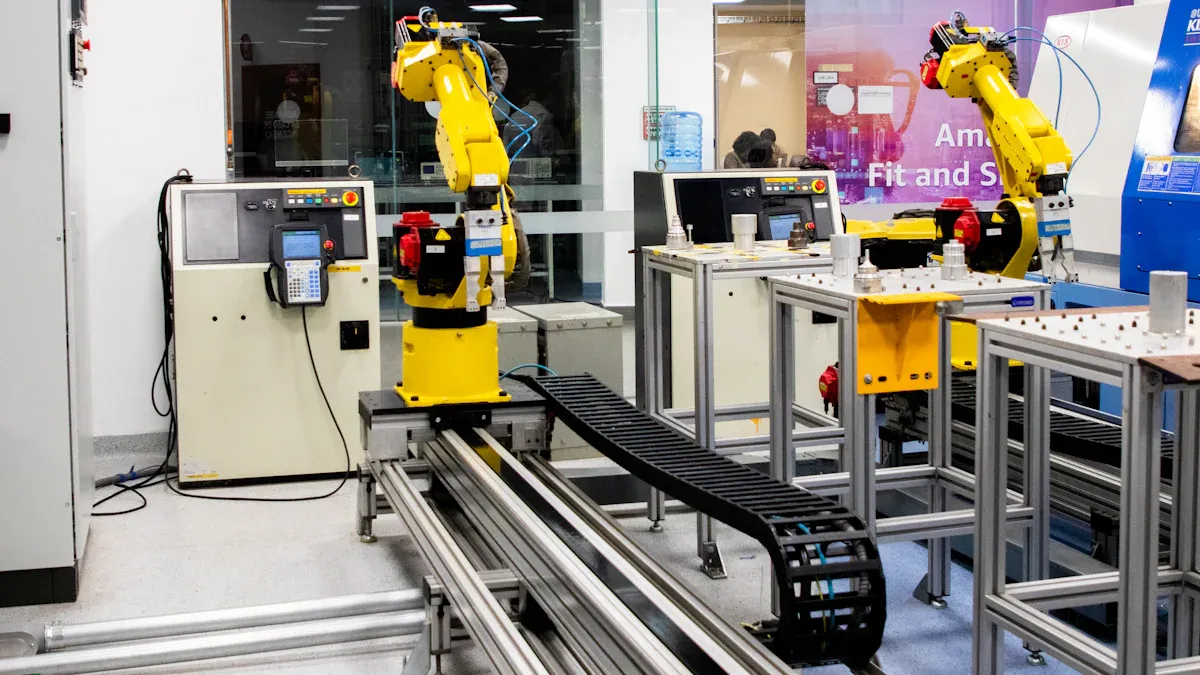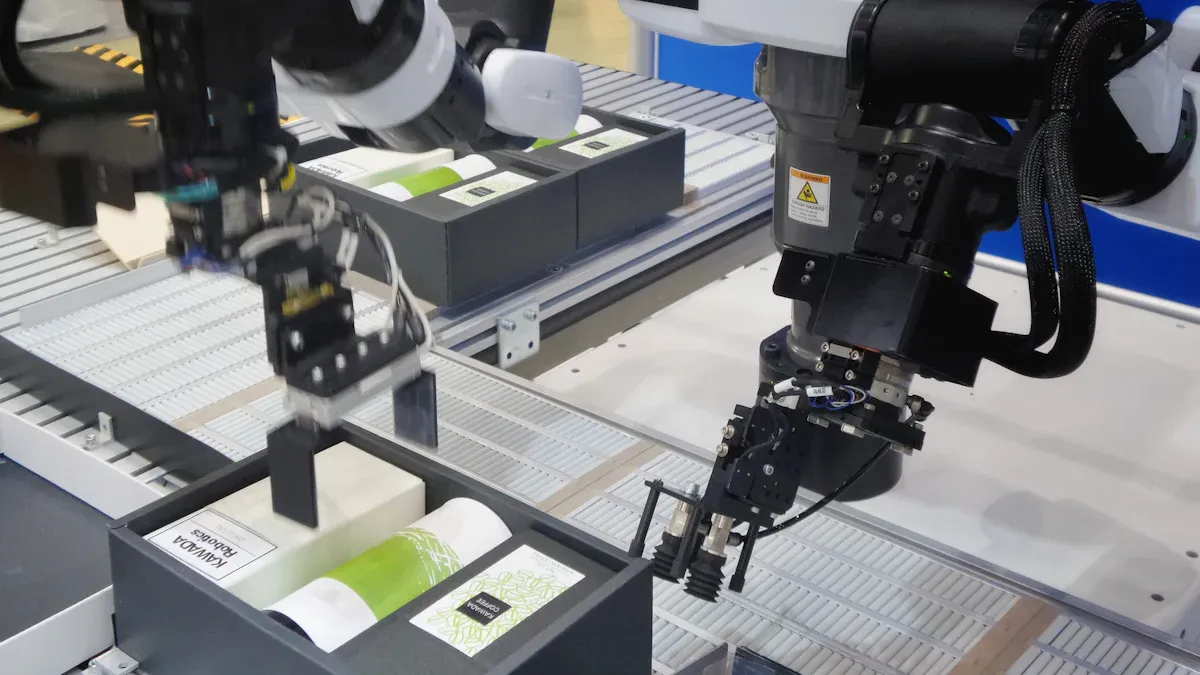
IP67 rated industrial IoT hardware assembly is designed for tough environments. It effectively keeps out dust and water, making it suitable for locations like paint lines where equipment is frequently washed. This robust design ensures reliable performance and minimizes delays. Proper assembly is crucial to maintain its IP67 rating; incorrect assembly could compromise its ability to withstand harsh conditions. Adhering to clear steps is essential to avoid mistakes and ensure the hardware remains durable and functional.
Always focus on details during the assembly of IP67 rated industrial IoT hardware to protect your gear and achieve the best results.
Key Takeaways
Pay attention to small details to keep the IP67 rating strong.
Use proper tools and materials, like steel and silicone seals, to block dust and water.
Work in a clean and safe area to avoid errors and work faster.
Check and test your hardware often to find problems early and meet IP67 rules.
Change old seals and gaskets quickly to keep your hardware working well in tough conditions.
Tools and Materials for IP67 Rated Industrial IoT Hardware Assembly

Tools you need for assembly
To put together IP67-rated industrial IoT hardware, you need strong tools. Start with simple tools like screwdrivers, pliers, and wrenches. Use torque wrenches to tighten screws just right. This keeps the IP67 seal safe. For wires, use wire strippers and crimping tools. A multimeter checks if electricity flows correctly and finds problems.
For harder tasks, use a heat gun for shrink tubing. A soldering iron helps make strong wire connections. If your project uses IP67 embedded systems, get special tools like cable testers and network analyzers. These tools keep your IoT system working well.
Materials and parts you need
Picking the right parts is key for IP67 compliance. Use tough materials like stainless steel or anodized aluminum for pushbuttons. Silicone-gasketed screws and washers stop air and water leaks. Strain relief bushings and cord grips protect cables and keep the IP67 rating.
For IoT projects, use parts like industrial switches, lights, and power supplies. Battery holders and fuse holders help manage power safely. An IP67-rated 4-port managed switch gives strong network connections. These parts make your IoT system reliable in tough places.
Part Type | Material | IP Rating | Features |
|---|---|---|---|
Stainless Steel, Aluminum | Up to IP67 | Different lights, 10-40 mm size | |
Silicone-Gasketed Screws & Washers | Various Materials | IP66/68 | Air-tight, long-lasting, UL listed |
Liquid-Tight Cord Grips | Various Materials | IP68 | NEMA rated, UL listed |
Strain Relief Bushings | Various Materials | Up to IP68 | Snap-in design, cULus listed |
Safety gear and workspace setup
Safety is very important when building IP67-rated IoT hardware. Wear goggles, gloves, and anti-static wrist straps to avoid shocks. Work in a clean, bright area without dust or moisture. Use grounded mats and ESD-safe tools to protect parts.
Keep your workspace at the right temperature and humidity. Always turn off power before touching electrical parts. A neat workspace keeps you safe and helps you work faster.
Category | Details |
|---|---|
Keep the right temperature, humidity, and clean space. | |
Safety Rules | Turn off power and check for dangers before starting. |
ESD Protection | Use wrist straps and grounded tools to stop static damage. |
Tip: Keeping your workspace clean helps avoid mistakes and keeps your IP67-rated IoT hardware lasting longer.
Step-by-Step Guide to Assembling IP67 Rated Industrial IoT Hardware

Preparing the workspace
Setting up your workspace is the first important step. A clean and safe area helps you work better and avoid mistakes. Start by clearing dust, moisture, and clutter from your table. Use special mats and tools that stop static electricity to protect parts.
Follow these safety tips for your workspace:
Think about your workplace needs and risks.
Look for dangers before starting work.
Use checklists to follow safety rules.
Check the table below for more workspace tips:
Requirement | Description |
|---|---|
Air Emissions | Check air quality to meet safety rules. |
Waste Management | Handle waste properly to protect the environment. |
Water Management | Stop water pollution by managing water use. |
Soil Protection | Keep soil and water clean from harmful chemicals. |
Noise Control | Reduce loud sounds to keep the area safe. |
Tip: A tidy workspace keeps you safe and helps you work faster.
Inspecting and handling components
Before building your hardware, check all parts carefully. This makes sure they are good quality and not broken. Use tools to measure parts near where you are working. This saves time and ensures the parts meet IP67 standards for dust and water protection.
Testing is important to keep the IP67 rating. Tests may include checking for extreme temperatures, water resistance, and strength. Handle parts gently to avoid breaking them. Wear anti-static gloves and wrist straps to protect sensitive pieces.
Note: Checking and handling parts the right way keeps your hardware strong and reliable.
Assembling the enclosure and internal components
The enclosure keeps your hardware safe from dust and water. Start by placing parts like circuit boards and sensors inside. Make sure everything is secure and in the right place.
Use IP67-rated connectors to keep out dust and water. For example, mining equipment often uses these tough connectors. Arrange cables neatly and use strain relief to stop damage.
Seal the enclosure with silicone gaskets or similar materials. Tighten screws to the correct level to keep the seal strong. Don’t tighten too much, as it can harm the gasket and ruin the seal.
Tip: Check the seal and alignment carefully before moving on. Small mistakes here can cause big problems later.
Sealing for IP67 compliance
Sealing is very important to keep your IP67 hardware strong. A good seal blocks dust and water, even in tough places. To do this, follow clear steps carefully.
First, pick good sealing materials. Silicone gaskets, rubber O-rings, and liquid-tight cord grips work well. These materials stop outside elements from getting in. Before sealing, clean all surfaces to remove dust, grease, or water. Clean surfaces help the seal stick properly and stay strong.
When placing the seal, align it correctly with the enclosure. Do not stretch or squish the gasket unevenly, as this can leave gaps. Use a torque wrench to tighten screws to the right level. Tightening too much can break the gasket, while too little makes the seal weak. After sealing, check for gaps or misaligned parts.
Tip: Use IP67-rated parts like silicone-gasketed screws and washers for better durability.
Good sealing protects your hardware and makes it last longer. It helps IoT devices work well in hard places like factories or outdoors.
Testing for IP67 standards
Testing checks if your hardware meets IP67 rules. These tests make sure the seal works and keeps out dust and water. There are different ways to test for leaks.
Testing Method | Description |
|---|---|
Pressure Decay | Finds leaks by measuring pressure changes. |
Vacuum Leak | Uses a vacuum to spot leaks in the seal. |
Tracer Gas Leak | Uses gas to detect small leaks in the seal. |
To do these tests, you need special tools like pressure testers, vacuum testers, and gas detectors. These tools find tiny leaks that could ruin the IP67 rating.
After checking the seal, test the hardware for IP67 compliance. This includes dust protection and water resistance. IP67 means no dust gets in and the device can stay in water up to 1 meter deep for 30 minutes.
Feature | Description |
|---|---|
Protection Level | Meets IP67 standard of IEC 60529 |
Dust Protection | Fully blocks dust from entering |
Water Immersion | Stays safe in water up to 1 meter deep for a short time |
Equipment Type | Uses tools for both IP6X and IPX7 tests |
Note: Knowing these ratings helps ensure your IoT devices work well in different places.
By testing carefully, you make sure your IP67 hardware works in real-life conditions. This step is key for IoT projects, as it ensures your devices are tough and reliable.
Common Mistakes in IP67 Rated Industrial IoT Hardware Assembly
Even with good tools, mistakes can weaken your IP67 hardware. Knowing these errors helps you avoid them and keep devices strong.
Wrong sealing methods
Sealing is key for IP67 protection. Bad sealing lets dust and water in. Skipping checks before assembly is a common mistake. Always check parts to ensure they meet the needed standards. Tightening screws too much or too little is another issue. Use a torque wrench to tighten screws correctly. Ignoring instructions from the manufacturer can also cause problems. Follow their steps carefully for the best results.
Bad sealing weakens the enclosure’s protection. Make sure seals fit properly and use the right sealant. Testing seals is important to confirm they work well. These tests help keep the IP67 rating strong.
Mistake | How to Avoid |
|---|---|
Skipping Pre-Assembly Checks | Check all parts to ensure they meet the needed standards before starting. |
Over-Tightening or Under-Tightening | Use a torque wrench to tighten screws to the correct level. |
Ignoring Manufacturer Instructions | Follow the product instructions carefully for proper assembly. |
Poor Sealing Practices | Ensure seals fit well and use the right sealant or lubricant. |
Tip: Clean all surfaces before sealing to remove dust or grease. This makes the seal stronger.
Using the wrong materials
Using bad materials can make your hardware fail. For example, non-IP67 connectors or enclosures won’t last in tough places. Avoid materials like plastic that break in heat or chemicals. Instead, use strong materials like stainless steel or aluminum for parts.
Cables face tough conditions like water and salt spray. Using the wrong cables or seals can cause rust or damage. Always pick materials rated for IP67 and suited for the environment.
Note: Weak materials can harm your hardware. Choose durable, high-quality parts for better performance.
Skipping IP67 testing
Skipping tests is a big mistake. Testing checks if your hardware meets IP67 rules. Without it, devices might fail in real-world use.
IP67 tests include pressure, vacuum, and gas leak checks. These find tiny leaks that could ruin the seal. Testing also ensures the device can stay in water up to 1 meter deep for 30 minutes.
IP Rating | What It Protects Against |
|---|---|
IP66 | Dust and water from strong jets. |
IP67 | Dust and water when submerged up to 1 meter for 30 minutes. |
Cables must also pass tests for heat, water, and submersion. Testing finds problems early so you can fix them before using the hardware.
Tip: Always test your hardware after assembly to ensure it meets IP67 standards.
Avoiding these mistakes keeps your IP67 hardware strong and reliable. Good sealing, materials, and testing are key for success in tough environments.
Tightening Fasteners Correctly
Fasteners are important for keeping IP67-rated industrial IoT hardware strong. Tightening them the wrong way can cause problems. If you tighten too much or too little, the hardware may not last long. Knowing these issues helps you avoid mistakes.
Using too much force when tightening can damage threads. This might stretch or break the fastener. If it breaks, dust and water can get inside the hardware. Tightening too little is also bad. It makes the fastener loose over time. Loose fasteners can misalign parts or weaken the seal. Both problems can ruin the IP67 seal and let in harmful elements.
Problem | What Happens |
|---|---|
Too Tight | Threads stretch or break, causing failures. |
Too Loose | Fasteners loosen, leading to misalignment or weak seals. |
Bad Joint Design | Uneven loads on fasteners cause early failure. |
To fix this, use a torque wrench to tighten fasteners correctly. Follow the torque levels given by the manufacturer. For example, tightening screws to the right level keeps the IP67 rating safe.
Check fasteners for damage before using them. Replace any that are rusty or bent. Good joint design also spreads the load evenly, making fasteners last longer. By doing these steps, your IoT hardware will stay strong and work well in tough places.
Tip: Check your tool’s torque settings before starting. This small step can prevent big problems.
Maintenance Tips for IP67 Rated IoT Hardware
Regular inspection and cleaning
Check your IP67 hardware often to find problems early. Look for cracks, rust, or loose parts. Focus on seals and gaskets since they keep the IP67 rating strong. Use a flashlight to check hidden spots for dust or water inside.
Cleaning is also important. Wipe the hardware with a soft cloth to remove dirt. For tough stains, use a mild cleaner on the cloth. Avoid strong chemicals that might harm seals or parts. Dry everything well after cleaning to stop moisture buildup.
Tip: Clean and inspect your hardware regularly to keep it working well.
Replacing seals and gaskets
Seals and gaskets protect your hardware from dust and water. Over time, they wear out due to heat, pressure, or chemicals. Replace them if they crack or lose flexibility.
Different seals work better in certain conditions:
Nitrile seals resist oil but may stiffen in extreme cold.
Viton® seals handle heat and chemicals, great for factories.
EPDM seals resist sunlight and weather, good for outdoor use.
Pick seals that match where your hardware is used. Changing worn seals on time helps your devices last longer.
Protecting against extreme conditions
Extreme conditions can damage your hardware. Heat, vibrations, and chemicals weaken seals and parts. Use enclosures made of stainless steel or aluminum for extra strength and corrosion resistance.
For places with changing temperatures, use polyurethane seals. They resist wear and damage well. Install hardware away from direct sunlight, heavy rain, or chemical spills.
Note: Test your IP67-rated hardware often to ensure it handles tough conditions. Testing keeps your devices reliable and safe.
Periodic IP67 compliance testing
Regular IP67 testing keeps your IoT hardware working in tough places. Over time, seals and gaskets can wear out from heat or moisture. Testing often helps find problems early and keeps the hardware strong.
Plan tests based on how your devices are used. For example, hardware in bad weather or with lots of shaking needs more checks. Use tools like pressure testers to check seals for leaks. These tools find tiny gaps that could break the IP67 seal.
Check spots that wear out fast, like cable openings and screws. Replace broken seals or gaskets right away. Always pick materials made for IP67 to keep the protection strong. Test sensors, connectors, and other parts too. This makes sure the whole system works well in real-life conditions.
Write down test results to track how your hardware performs. Records help you improve designs and plan better maintenance.
Tip: Test water resistance in a safe place to check submersion. This step is key to keeping the IP67 rating.
By testing regularly, your IoT devices last longer and work better in hard conditions. This saves time, avoids problems, and protects your investment.
Putting your hardware together the right way keeps it strong. It also helps it stay safe in tough places. Follow the steps to avoid mistakes like bad sealing or missing tests. Every step, from setting up your workspace to testing, is important for success. Checking your hardware often and changing worn gaskets makes it last longer. These habits keep your devices working well for a long time. By doing this, you protect your money and make sure your IoT hardware works great in hard conditions.
FAQ
What does IP67 mean for industrial IoT hardware?
IP67 means the hardware is safe from all dust. It can also stay in water up to 1 meter deep for 30 minutes. This makes it strong for tough places like factories or outdoors.
Tip: Always check the IP rating to match your environment’s needs.
Can I reuse gaskets and seals during reassembly?
No, you should not reuse old gaskets or seals. Reusing them can weaken the IP67 protection. Always use new seals to keep out dust and water.
Note: Check seals often for cracks or damage to avoid problems.
How often should I test for IP67 compliance?
Test your hardware regularly based on how it’s used. For harsh conditions, test every 6–12 months. Testing keeps the hardware reliable and its IP67 rating strong.
Reminder: Write down test results to track how well it works.
What tools are essential for IP67 assembly?
You need tools like screwdrivers, pliers, and a torque wrench. Use a multimeter and pressure tester to check assembly and IP67 compliance.
Tip: Use good-quality tools to avoid breaking delicate parts.
Can IP67-rated hardware handle extreme temperatures?
Yes, but only within the temperature range given by the maker. Too much heat or cold can harm seals and parts, making them weaker.
Advice: Check the product’s datasheet for its safe temperature range.
See Also
Essential Strategies to Enhance PCB Assembly Productivity
Key Strategies for Overcoming PCBA Manufacturing Obstacles
Ten Professional Insights for Cost-Effective PCBA Assembly
Creating Tailored Android PCBAs for Specialized Device Requirements